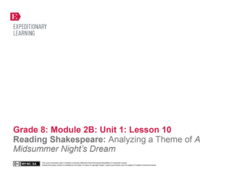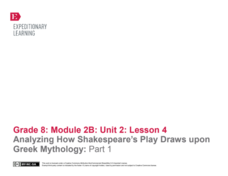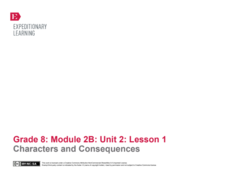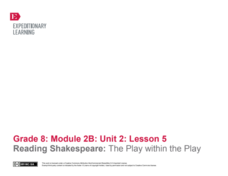Curated OER
A Midsummer Night's Dream
You might not be able to put a girdle around the earth in forty minutes but you can generate interest in A Midsummer’s Night Dream in that length of time. As an introduction to Shakespeare’s comedy, pairs of students assume the roles of...
Curated OER
William Shakespeare's 'A Midsummer Night's Dream': Conflict Resolution and Happy Endings
Learners analyze the characters and conflicts in Shakespeare's 'A Midsummer Night's Dream. For this conflict resolution lesson, students read the play and track the character actions with the specific plots. Learners then predict endings...
EngageNY
Analyzing Character and Theme: Tracking Control in A Midsummer Night’s Dream
Pupils first participate in a drama circle as they continue reading Shakespeare's A Midsummer Night's Dream aloud with classmates. Next, scholars move around and discuss text-dependent questions about the play with a Three Threes in a...
EngageNY
Launching A Midsummer Night’s Dream: The Universal Appeal of Shakespeare, Part 2
As scholars prepare to read Shakespeare's A Midsummer Night's Dream, they first read the article "Shakespeare's Universal Appeal Examined" and analyze its central idea. Next, pupils complete Frayer Model worksheets to understand better...
EngageNY
Launching A Midsummer Night’s Dream: Identifying the Characters, Settings, and Conflicts
Scholars form a drama circle and begin reading Shakespeare's A Midsummer Night's Dream. They also use a play map to identify the setting, characters, and conflicts from the text.
EngageNY
Reading Shakespeare: Analyzing a Theme of A Midsummer Night’s Dream
After finishing Act I, scene 1 from Shakespeare's A Midsummer Night's Dream, class members study the theme of control as it relates to the play and start an Evidence of Control note-catcher worksheet.
EngageNY
Analyzing Character and Theme: Tracking Control in A Midsummer Night’s Dream
Scholars examine how characters try to control one another in Shakespeare's A Midsummer Night's Dream. They engage in a read-aloud and class discussion to iron out ideas. They also work in small groups to complete a note-catcher...
Curated OER
Relationship Role Plays from A Midsummer Night's Dream
Connect a scene from a class play to events in your middle and high schoolers' own lives. First, they act out a scene from A Midsummer Night's Dream in pairs. They work to role play a scene as an extension of the one they have read,...
Curated OER
A Midsummer Night's Dream by William Shakespeare
Young scholars read and perform William Shakespeare's A Midsummer Night's Dream. In this Shakepeare play activity, students read the script for the play and practice the simplified version of the play.
Curated OER
A Midsummer Night's Dream
High schoolers examine patterns of imagery in A Midsummer Night's Dream by using online resources. Students compare the patterns they see to those they've found in other Shakespeare plays. Then high schoolers draw conclusions about why...
Curated OER
A Midsummer Night's Dream
Middle schoolers explore the book A Midsummer Night's Dream. In this literature lesson, students identify main characters and vocabulary words from the text. Middle schoolers participate in a book discussion group.
Curated OER
Guess that Scene: A Review of A Midsummer Night's Dream Through Performance
Pupils rewrite and perform various scenes from the play, A Midsummer Night's Dream. In groups, they include the main quotes and ideas from their scene, perform it for the class, and identify which scene each group is performing.
EngageNY
Analyzing How Shakespeare’s Play Draws upon Greek Mythology: Part 1
Scholars read the story "Pyramus and Thisbe," analyzing word choice, tone, and meaning. They then try to find the gist of the story and discuss how Shakespeare used the myth in his play A Midsummer Night's Dream.
Curated OER
I WILL NOT HEAR THAT PLAY: PERFORMING A DUMB SHOW
Young scholars perform a "dumb show" based on a short passage from either A Midsummer Night's Dream or King Lear. This technique allows students to explain the action taking place on stage and the variety of different ways that action...
Curated OER
Shakespeare Club
Students explore literature dramatization. In this Shakespeare lesson, students discuss the characters from the play A Midsummer Night's Dream and construct costumes and a set.
Curated OER
A Midsummer Night's Dream
Students explore the world of love and magic in William Shakespeare's A Midsummer Night's Dream. Comparisons are made to the life experiences of the reader as love's portrayal in contemporary situations are analized.
Curated OER
"Such Affection Move": Finding Staging Clues in A Midsummer Night's Dream
Students perform various scenes from the play, A Midsummer Night's Dream. They examine and discuss the text and stage directions, then perform their scenes in small groups for the class.
EngageNY
Text to Film Comparison: Bottom the Fool
Pretty ugly, jumbo shrimp. Oxymorons are awfully good! Scholars reread Act I, scene 2 from Shakespeare's A Midsummer Night's Dream while participating in a drama circle. Next, they begin working on anchor charts to dissect Shakespeare's...
EngageNY
Author’s Craft: The Poetry of the Play
Feel the rhythm! Pupils begin reading Act 2, Scene 1 of Shakespeare's A Midsummer Night's Dream as they continue participating in a drama circle. With discussion, they examine Shakespeare's use of rhyme, rhythm, and meter, analyzing how...
EngageNY
Reading Shakespeare: Understanding Shakespeare’s Language
Pupils participate in a drama circle to read Shakespeare's A Midsummer Night's Dream aloud. They work with partners to discuss Shakespeare's use of language and analyze how specific lines of dialogue within the play help propel the...
EngageNY
Characters and Consequences
Scholars consider how dialogue reveals aspects of a play's characters as they read Shakespeare's A Midsummer Night's Dream and complete a written conversation note-catcher. Additionally, pupils participate in an I Have/Who Has jigsaw...
EngageNY
Analyzing the Resolution of the Play: World Café Discussion
It's time to get active! Scholars participate in a World Café protocol to promote discussion and leadership. They leave their seats and move from group to group to discuss critical questions related to their read-aloud of Shakespeare's A...
EngageNY
Reading Shakespeare: The Play within the Play
Scholars continue reading the Greek myth "Pyramus and Thisbe," analyzing why it was written into Shakespeare's A Midsummer Night's Dream. Next, they complete a Venn diagram to compare the two texts.
EngageNY
Analyzing How Shakespeare’s Play Draws upon Greek Mythology: Part 3
How do the narrative and play versions of the myth "Pyramus and Thisbe" affect meaning? Scholars reread Act 5, Scene 1 from Shakespeare's A Midsummer Night's Dream and compare its structure to "Pyramus and Thisbe." Next, they use a...























